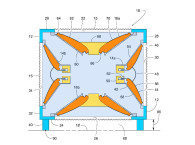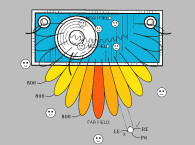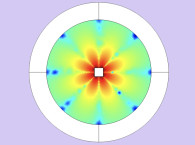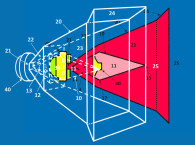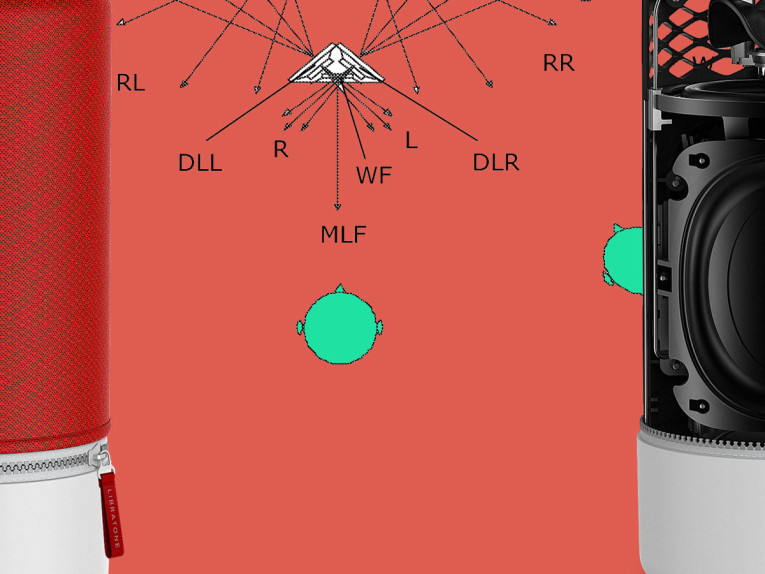
Compact Stand-Alone Stereo Loudspeaker
Patent Number: US20130336504
Inventor: Jes Mosgaard (Silkeborg, Denmark)
Assignee: Libratone A/S (Skovlunde, Denmark)
Filed: June 10, 2010
US Classes: 381/300
Published: December 19, 2013
Number of Claims: 15
Number of Drawings: 6
Abstract from Patent
Stereo loudspeaker in a single cabinet (CB), such as a portable stereo loudspeaker. Two dipole loudspeaker units (DLL, DLR) generate respective acoustic dipole signals (L+, L-, R+, R-) in accordance with two channels on an input signal. The two dipole loudspeaker units (DLR, DLL) are closely spaced and oriented such in relation to each other that their respective main axes are angled (.alpha.) 70°–110°, such as 80°–100°, preferably substantially 90°, relative to each other. By placing such stereo loudspeaker in a room in front of a wall (W), reflections (RL, RR) from one side of the two dipole units’ (DLL, DLR) diaphragms will reach a listener and thus serve to provide, together with the direct sound (L, R) from the opposite side of the diaphragms, a stereo image in a wide area in the room.
The dual dipole arrangement enables a one-cabinet stereo loudspeaker with a narrow design. The dipole arrangement may be a two-way system with dipole tweeter units and dipole mid range units. A mono low-frequency unit (WF) may be included in the cabinet (CB). The stereo loudspeaker can be configurable to either play stereo or to play mono (i.e., the dipole units) playing the same signals. Hereby the loudspeaker can play one channel while a similar loudspeaker plays another channel, thus allowing such set of loudspeakers to be used in a traditional stereo setup.
Independent Claims
1. A loudspeaker arranged to receive an input signal with first and second channels and to generate respective first and second acoustic signals accordingly, the loudspeaker having a cabinet (CB) comprising: a set of first and second dipole loudspeaker units (DLL, DLR) arranged to receive respective left and right channel signals and to generate respective first (L+, L-) and second (R+, R-) acoustic dipole signals accordingly, wherein the first and second dipole loudspeaker units (DLL, DLR) are closely spaced and oriented in relation to each other such that their respective main axes are angled 70°–110° relative to each other, wherein the first and second dipole loudspeaker units (DLL, DLR) are placed in the same horizontal plane, and wherein both of the first and second dipole loudspeaker units (DLL and DLR) are mounted in the cabinet (CB) so as to freely radiate their respective acoustic dipole signals (L+, L-, R+, R-) away from the loudspeaker.
33. A method for playing an input signal with first and second channels, the method comprising: receiving the input signal, and applying electrical signals corresponding to left and right channels to respective first and second dipole loudspeaker units arranged to generate respective first and second acoustic dipole signals accordingly, wherein the first and second dipole loudspeaker units are mounted closely spaced in a cabinet are oriented such in relation to each other that their respective main axes are angled 70°–110° relative to each other, wherein the first and second dipole loudspeaker units (DLL and DLR) are arranged in the cabinet (CB) with their main axes substantially being in a horizontal plane, and wherein both of the first and second dipole loudspeaker units (DLL and DLR) are mounted in the cabinet (CB) so as to freely radiate their respective acoustic dipole signals (L+, L-, R+, R-) away from the loudspeaker.

Reviewer Comments
Compact enclosure two-channel systems with a pair of closely spaced stereo transducers and built-in amplifiers in a single cabinet are currently one of the most popular ways of playing stereo. Because the physical distance between the left- and right-channel speakers is so small, to enhance the perception of a wide sound stage, a large variety of signal processing manipulations are incorporated to provide spatial effects, but such processing either tends to decrease overall sound quality (e.g., the timbre) or the spatial effect is only present when the listener is perfectly centered between the left and right transducers.
To receive a stable spatial stereo effect, without signal processing, again, the listener must be in the correct position for an acceptable stereo presentation, and thus with closely spaced loudspeakers, this can only be obtained in a limited listening area around the central position. Listening outside the “sweet spot,” a closely spaced pair of loudspeaker units will tend to be experienced as a mono source and any spaciousness of the image will be lost. Furthermore, to provide a certain stereo effect even in the “sweet spot,” the pair of loudspeaker units must be separated by a minimum distance, and thus, most of the compact units use a shallow and wide form factor to achieve as much stereo spread as possible, substantially eliminating the possibility of narrow forms of industrial design.
In view of these issues, the disclosed invention is intended to provide a compact and portable stereo loudspeaker system that is capable of providing a spacious sound field, and to maintain that spaciousness when perceived from listening positions outside the area in front of, and centered on, the internal stereo pair of loudspeakers.
The single enclosure comprises a set of first and second dipole transducers, arranged to generate respective first and second dipole acoustic outputs corresponding to the first and second stereo input signal channels, wherein the first and second dipole loudspeaker units are closely spaced and oriented such in relation to each other that their respective main axes are angled between 70° and 110°, preferably around 90°, relative to each other (as shown in Figure 1 and Figure 2).
It is claimed that such a configuration is advantageous in providing a spacious sound field due to the dipole loudspeaker configuration, which enables a stereo presentation to be radiated both forward and rearward from the enclosure. Thus, when the loudspeaker cabinet is oriented in a room with its front towards a listening area, the listener will not only experience a stereo sound due to the direct sound from the first and second dipoles, but also the stereo signals from the back of the loudspeaker, which arrive to the listener reflected off the walls in the listening room. The perceived sound field experienced by the listener can be quite large, and in principle, spread throughout at least the front half of the listening room. Additionally, the closely spaced dipole units enable a very narrow cabinet design, which is preferred by the industrial designers at Libratone of Denmark, the assignee of the invention.
The “dipole loudspeaker transducer” can be realized with a standard, cone-based, open-back, electrodynamic transducer, since such units are inherently acoustic dipoles. However, the dipole polar pattern can also be provided by configuring two separate loudspeaker units, (e.g., two dome tweeters mounted back to back). Such a configuration will, at least up to a certain frequency, act as a pure acoustic dipole when electrically connected in opposite phase. In the actual Libratone production units, such as the Libratone Live, Omni, and Loop models, the dipole devices are planar magnetic transducers with thin film polymer diaphragms.
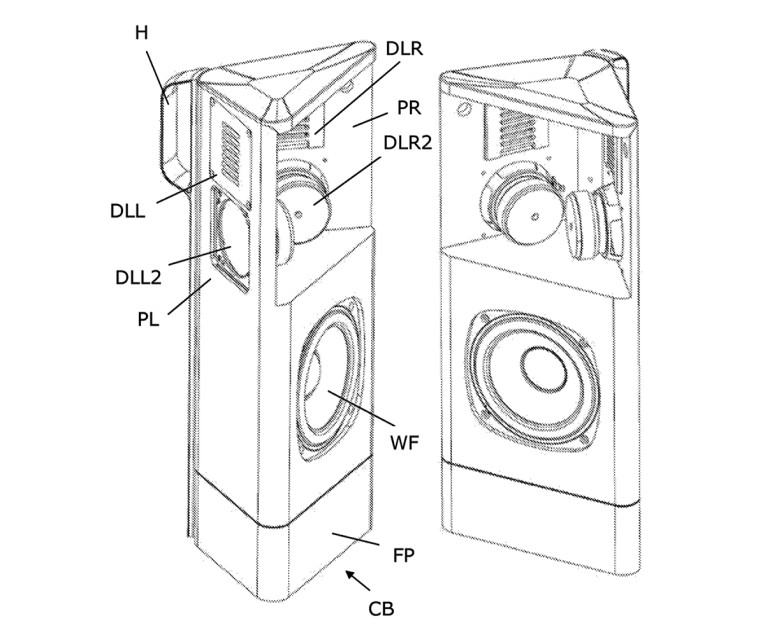
With this configuration, it is possible to position the two dipole units so closely together that the zero points in their dipole radiation patterns coincide, when seen in top view, which means that the two units can in principle be placed right above each other, and thus a cabinet with a width as narrow as the lateral dimension of one single transducer unit would be possible. It is preferred that the first and second dipole loudspeaker units are spaced with a distance between centers of their diaphragms being smaller than two times a maximum end on end width of their diaphragms.
Preferably, one side of the diaphragms of the first and second dipole loudspeaker units are arranged to generate direct sound to the listener, and the opposite side of the diaphragms of the first and second dipole loudspeaker units are arranged to generate sound to the listener via reflecting surfaces, such as walls.
Thus, it is preferred that the loudspeaker units are mounted in the cabinet such that the zero axis of the diaphragms of the two dipole transducer units are both angled to converge when projecting out of the front of the enclosure, and the 180° axis to acoustically spread when radiating out of the rear of the enclosure.
It is also preferably that the first and second dipole loudspeaker units are oriented such in relation to each other that their respective main axes are substantially perpendicular to each other. This configuration will provide the best separation between left and right stereo channels and thus provide the optimum stereo image. The recommended placement is in a room near a wall (behind the loudspeaker) so as to ensure that reflections from the wall will reach the listener via sidewalls or other reflecting surfaces in the room to maximize the spatial effect.
At first glance, the unit may appear similar to a single Bose 901 with separate right and left rear outputs angled to reflect off of a wall behind the speaker. But, by utilizing dipole sources to project the right and left channel outputs, there is also a dipole null created at the 90° angle of each transducer, which provides at least two useful attributes:
• A longer, high-separation delay path for the boundary-reflected rear wave relative to the front wave direct arrival, which creates a larger perceived spatial sound field
• For a listener moving off the central forward system axis, (e.g., to the right) a reduced output from right channel transducer relative to the output from the more distant left channel transducer, creates a time/intensity trade-off that results in a more stable stereo image for a wider range of off-center listening positions.
The simple dual-dipole approach can work well for providing an expanded and stable stereo sound field from a wide range of seating positions with a singular, portable two-channel enclosure. VC
Author’s Disclosure: Libratone utilizes the author’s patented planar magnetic transducer technology in the devices described in the above patent review.
This article was originally published in Voice Coil, February 2015



